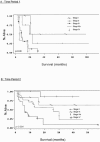An aggressive surgical approach leads to improved survival in patients with gallbladder cancer: a 12-year study at a North American Center
- PMID: 15729060
- PMCID: PMC1356976
- DOI: 10.1097/01.sla.0000154118.07704.ef
An aggressive surgical approach leads to improved survival in patients with gallbladder cancer: a 12-year study at a North American Center
Abstract
Objective: To determine if an aggressive surgical approach, with an increase in R0 resections, has resulted in improved survival for patients with gallbladder cancer.
Summary background data: Many physicians express a relatively nihilistic approach to the treatment of gallbladder cancer; consensus among surgeons regarding the indications for a radical surgical approach has not been reached.
Methods: A retrospective review of all patients with gallbladder cancer admitted during the past 12 years was conducted. Ninety-nine patients were identified. Cases treated during the 12-year period 1990 to 2002 were divided into 2 time-period (TP) cohorts, those treated in the first 6 years (TP1, N = 35) and those treated in the last 6 years (TP2, N = 64).
Results: Disease stratification by stage and other demographic features were similar in the 2 time periods. An operation with curative intent was performed on 38 patients. Nine (26%) R0 resections were performed in TP1 and 24 (38%) in TP2. The number of liver resections, as well as the frequency of extrahepatic biliary resections, was greater in TP2 (P < 0.04). In both time periods, an R0 resection was associated with improved survival (P < 0.02 TP1, P < 0.0001 TP2). Overall survival of all patients in TP2 was significantly greater than in TP1 (P < 0.03), with a median survival of 9 months in TP1 and 17 months in TP2. The median 5-year survival in TP1 was 7%, and 35% in TP2. The surgical mortality rate for the entire cohort was 2%, with a 49% morbidity rate.
Conclusions: A margin-negative, R0 resection leads to improved survival in patients with gallbladder cancer.
Figures




References
MeSH terms
LinkOut - more resources
Full Text Sources
Medical
Miscellaneous

